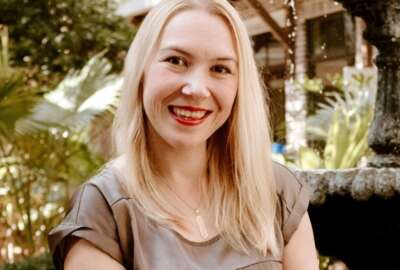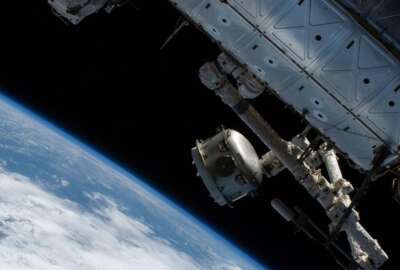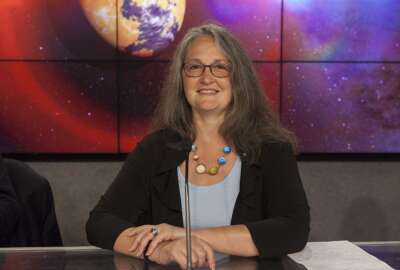A sneak peek at the newest class of engineers from an Air Force and NASA collaboration
The Air Force Research Laboratory (AFRL) and NASA are collaborating with eight American universities for the second year of the Mission Concept Program.
The Air Force Research Laboratory (AFRL) and NASA are collaborating with eight American universities for the second year of the Mission Concept Program. The program provides universities with assistance in helping students gain skills focused on early satellite mission design, through mentorship and guidance from space professionals. The Space Hour host Eric White had the chance to speak with two folks who are a part of the program, Seth Sisneros is a systems engineer with AFRL’s space vehicle directorate, and Emi Colman is deputy program manager for the lab’s University Nanosatellite Program.
Interview Transcript:
Emi Colman So, the mission concept program is something one of the efforts within the University Nanosatellite program. So just to give some more context there, University Nanosatellite program or UMP has existed since 1999. So, we’re in our 25th year, super exciting. We’re a STEM education focused program that is here to support universities and their labs to build satellites. So, the Mission Concept program really birthed a couple years ago. It’s a joint program with NASA Kennedy Space Center, and CSLI or CubeSat Launch Initiative, specifically. So, what we’re really trying to target here is new universities just trying to get into this space. It’s our entry level summer program to teach schools with mission design and concepting of their satellite. We ran it for the first-time last year, we’re doing it again this year, we’re super excited. And we really want to increase opportunities to schools that want to dip their toes into this small satellite industry. So that is what UMP is doing within the Air Force Research Lab. We are providing the curriculum and the funding. We’re also giving internships to these 24 students this year through Space Dynamics Laboratory, which is another contractor. Within this and my role, specifically, I’m the deputy program manager of University Nanosatellite program or UMP. So, my responsibility is to, you know, coordinate the logistics and make sure that, you know, everyone has equal say, between AFRL and NASA, you know, refining the curriculum. From the last time we did it last year, and just making sure that the ship is moving, so to say.
Eric White Yeah, absolutely. Yeah. And I’ll get back to you on the on those changes and curriculum that you all made from the first year. Seth, why don’t you talk a little bit about things on the engineering side? And where do you fit in? And all this?
Seth Sisneros Yeah, so as a systems engineer, what we do here within AFRL is really the entire the entire satellite build. On the engineering side, we’re teaching students the entire satellite build from cradle to grave, I mean, the entire concept, the engineering concept, seeing engineer development, and then the post development of these missions. So, we teach students, how do they go through designing their mission statement, designing their objectives, designing the requirements, understanding their customer, their stakeholder? And what is it they truly want out of a mission, and then they translate through systems engineering knowledge and practice that we give them in this curriculum. What really matters and how technically feasible is that? That’s really what we’re evaluating here. And what we’re teaching students is the systems engineering knowledge or practice to have feasible, successful missions within small satellites. It’s difficult, right? It’s not exactly rocket, or rocket science. But you know, it’s up there, it’s hard to do. A lot of people will underestimate or say, hey, it’s just small satellites, because that’s the world that we’re working in right now, Eric, just for background there. But you know, small satellites are still satellites. It’s still hard work. And so, it goes through these students go through a rigorous program through multiple reviews that we would see a flight missions from the Air Force and from the Space Force actually go through. So that’s through a slew of multiple reviews of the system concept review of system requirements review, and then eventually to critical design review or preliminary design review. So, it’s rigorous and stuff, but it’s meant to be that way so that the students really understand really get a good foundation for understanding the concept of mission design.
Eric White Yeah, let’s stay here because you know, the UMP has been around since 1999. But you really only have started to see the actual mean just from a person who covers it. standpoint, I’m sure you’ll disagree with me, but you really have only starting to see a lot of heavy use in the idea and concept of nanosatellites, and cube sats and things like that. Only recently. I mean, can you just kind of give us what you think of the standpoint of where things are currently and where this program could fit into that and building a workforce of the future.
Seth Sisneros Yeah, totally. It’s 25 Year program. And so, for myself, it’s almost a little bit limited point of view here with my experience within UNP, but just for the workforce side of things, because it’s 25 years, we’ve met a lot of people ourselves. So, between myself and Emi, and just other people, we know who UNP alumni are, there are a lot of UNP alumni who’ve graduated from multiple universities working in all areas of aerospace. So, whether they’re working for federal agencies, such as NASA, or for other DoD agencies, such as SSC, the Space Systems Command, or even AFRL, we’ve hired over 50 UNP alumni within our space vehicle structure alone, which is a lot it’s a lot of people. We’re estimating is anywhere between, and Emi, feel free to check me on this, 7000 to 8000 people who have graduated have gone out into industry. And so, we’ve met a lot of those alumni through other industry partners or contractors, so through Northrop Grumman, or through Boeing, Ball Aerospace, you know, just for a few examples there. So, we’ve seen these students really change the landscape of small satellites and of pushing forward and systems engineering practices that we’re teaching them. Right. Yeah. I mean, do you have anything to add on to that?
Emi Colman Yeah, I think 8000 is the estimate that’s currently in my head. And with this mission concept program, UNP has formally reached and formally mean, meaning that, you know, there was a formal proposal process and all of that stuff. We’ve reached 53, universities, US universities. So, we’re really encouraged by that number. And to kind of hit a piece of your question, Eric, although I don’t remember the specific question. Yeah, UNP exist as a workforce development STEM program for, you know, the small satellite industry, the government, you know, kind of like our whole nation, in a sense, we’re not one of our focus areas is technology development. Although that’s not our first and foremost focus. Our main focus is education. And really educating the students on like Seth said, the systems engineering principles and practices when they’re a freshman in college, so that they have this real-world experience from the cradle to grave. They’ve done some, you know, actual satellite design. And then, you know, once they get to the workforce, they’re, they’re that much further ahead. And it’s super impactful to them as a person as well.
Eric White I promised I wouldn’t, I’m going to stick to it here. You know, this is the second year of the Mission Concept program, if you could just lay out a couple of the changes that you saw in the curriculum from year to year and tell us a little bit about those universities participating this year? And how do you all measure success when it comes to the Missions Concepts program?
Emi Colman So, I’ll start in Seth, feel free to jump in changes to the curriculum, we wanted a bit more hands on. aspect. So, within UNP sits within the small satellite portfolio at Air Force Research Labs are AFRL. So, we have a satellite a CubeSat in space right now. So, you know, we were throwing around the idea in the office of Oh, wouldn’t it be cool if we had the students actually operate this satellite? So, Seth is actually focusing on doing a satellite operations week with these students. And it’s kind of a surprise, we haven’t told them yet. But we’re we will take them through, you know, a lecture series on, you know, the ground considerations, and how do you operate a satellite, and then we’ll actually get, let them operate the satellite. So we wanted to show kind of like the end cycle of the satellite design process to then help inform how to mission concept because once you have an actual, I guess, data point where you’re actually doing it, it kind of helps with this more abstract mission design mission concepting, more of the beginning side of the satellite design. Another thing that we’re doing is, we’re working with Jet Propulsion Lab, JPL, NASA, JPL, and their F prime software framework. So, some NASA folks are coming out here and giving a workshop on their software, which we’re super excited about JPL have run this a couple times. Once at like the small satellite conference. They do this with a bunch of different universities. So, we’re excited to expose our students to more technical software considerations.
Seth Sisneros Yeah, and just to add on to there. Emi is spot on. She hit a few of the, like, specific examples of that we’ve changed to this curriculum, but like to more encompassing, I guess, our broader scope Eric on in terms of changes to the curriculum, and what we’re trying to do Is pack as much of the entirety of a satellite’s life and give all that knowledge. But really, it’s a fire hose that we’re giving to the students in a span of two to three months. So, we’re trying to show Hey, this is how long this is the in depth, give them a preview a peek into the years and the time and expertise that takes into building a satellite. But we’re giving them a peek into that now within two to three months in this crash course of a program. And so, these students really get the valuable opportunity. As you know, earlier, I alluded to like cradle to grave operations. Because that takes so many years, these students, you know, within this time span, obviously, can’t take part of that. But what we’re doing is we’ve been adding a curriculum, we’ve been adding experts’ expertise, specific topics from that we’ve learned within our branch, about satellite operations and commanding. We added in these topics to these students say, Hey, you’re not going to be you know, years off for making a satellite. But keep in mind, you need to work on new ground, your ground station, keep in mind that you need to work on your flight software, keep in mind that this is what satellite operations is actually looking like for a satellite in orbit today. So not only we’re giving them the chance to fly satellite, giving them the chance to work with hardware the we’ve developed, but also to, you know, by time they get into industry in their own or while they’re in college working on their own satellite mission, they can have that in mind the entire time looking towards the future. That’s the part of the, you know, overall scope and change in curriculum that I would say we’ve made this, so far this year.
Emi Colman Another big piece of the Mission Concept program that we hadn’t mentioned was the reason why we’re targeting people that are just wanting to step into the small satellite industry is because we have a lot of opportunities for university, you know, NASA CSLI, us, NSF has stuff, there’s a lot of different STEM opportunities, but they’re competitive with their proposal process. So, one of the outcomes of that we’re hoping to do is to make their proposals a bit more on par with the competition. So although we’re not directly doing like a proposal writing workshop, we are having a principal investigator, the professors in the PI’s, a focus lecture series, where we take in professors that have been doing this for the past 20 years, or the past 15 years, or just started and kind of let them network let them have, you know, an intimate conversation on, you know, how do you start your lab? How do you get students excited? How do you retain lab knowledge across years? How do you actually close a satellite? So, we’re actively having these conversations this summer. And that’s been a huge change that we did in the curriculum, with the hope that these PI’s and professors and the labs and the universities can kind of have, you know, some sort of foundation to start, as well.
Eric White Let me set the table here. And Seth, maybe give you the last word on where you think this could all be going and how this will kind of evolve over time as the industry itself evolves? Pretty quickly. I would have to say, I don’t know if you agree with that. But I’ll get your insight here.
Seth Sisneros Yeah, absolutely. Yes. Yeah, I totally agree. I think the landscape is has been changing dramatically. I mean, even just, you know, talking about like launch vehicles alone. We’ve seen the landscape of launch vehicles and flights that are happening regularly changed dramatically. It’s increased dramatically. We’re having reasonable rockets, right. We’re having flights with highest success rates; with less harm or damage we’ve seen ever before right revving two to three launches. We, you know, we just kicked off the program, Kennedy Space Center, and one of our partners in this, Jose Nunez from NASA, he was mentioning how you know, launches are happening every you know, it’s every week for two to three times a week, which is unprecedented. It’s huge. So yeah, we’re expecting the, from this. The Mission Concept program is going to play into that by maturing universities and maturing the students themselves and their satellite hardware and software understanding and in their systems engineering practices, but also the university PIs themselves. So, the professors, the professors who are getting new into the world of satellite technology, the university labs, so the laboratories, enabling them to work on this technology at a faster pace, and with more hardware experience, more software experience in mind. So yeah, we definitely plan to see a change in there in these universities, university lab students and the laboratories. And from there, it’s only going to exponentially grow, at least from what I’m anticipating personally, because these students will then go into the workforce and, you know, continue to push this technology forward. Yeah, so we’re expecting a huge change for us, in particular with UNP. We’re planning to release another RFP later this year for our Nanosat 12 or Nanosat cycle, yeah. So, we’re actually anticipating a lot of these universities have participated with us last year for summer 2023. And for this summer of 2024, we’re actually anticipating a lot of them to use the ideas that we taught them last summer and this summer through the Mission Concept program and assessing the technical feasibility of the proposals that they get to us. So yes, we’re very positive. We’re looking forward to seeing a high growth rate from our next Nanosat cycle with these university students who are involved in this who’ve never had a chance to before.
Eric White That’s Cisneros, a system engineer with the Air Force Research Laboratory. You also heard from me Colman, who is deputy program manager for the labs University Nanosatellite program. You can find this interview along with all of our interviews and previous episodes at Federal News network.com Search the space hour. You can also find us wherever you get your podcasts.
Copyright © 2025 Federal News Network. All rights reserved. This website is not intended for users located within the European Economic Area.
Eric White is news anchor and Federal Drive producer at Federal News Network.
Follow @FEDERALNEWSCAST






